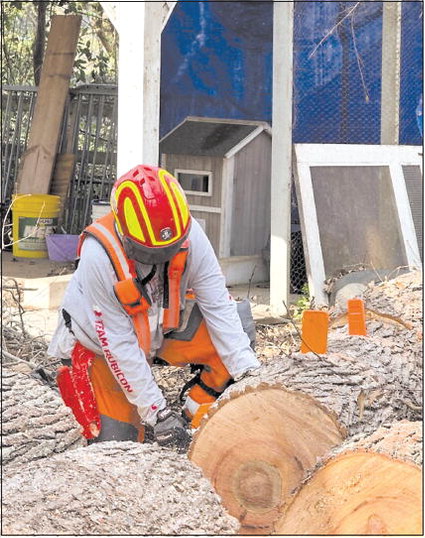Team Rubicon: Helping Cut The Path to Normalcy


mrandolphadvance@gmail.com
For four months following Hurricane Helene, Team Rubicon has worked to help “cut the path to normalcy” through their volunteer chainsaw crew efforts in Toombs County.
According to Commander Bill Blair, who helped lead the organization’s Toombs County deployment, Team Rubicon is a veterans-led disaster response organization that began in January 2010, when Co-Founder Jake Wood had just retired from the U.S. Marine Corps, where he served as a scout sniper in Afghanistan and Iraq. “He was sitting in his apartment and was watching TV and seeing what was unfolding in Haiti after the 7.2 magnitude earthquake. He wanted to do something so he called up an organization and said, ‘Hey, I have this skill set; I would like to volunteer. What do I need to do?’ And they said, ‘Well, we’re not taking volunteers, but we’ll take your donation,’” Blair explained.
This willingness to accept money but not help bothered Wood, leading him to contact several of his college friends and craft a plan to go volunteer in the nation. Wood and 3 of his friends flew to the Dominican Republic, where they met 3 other men who were self-deploying to help in the area. The men joined forces and met up with another man – Jesuit Brother and Haitian School Teacher Jim Boyeston – who helped to lead the crew into Haiti. The men spent 3 weeks doing triage for Haitians with minimal supplies. “After the first day, Jake said, ‘I want to build the best disaster-response organization in the world,’” Blair emphasized.
Thus, Team Rubicon was born and began deploying crews of volunteers throughout the United States, and sometimes even the world, to help those who had just experienced natural disasters, such as wildfires, hurricanes, floods, mudslides, and more. “The disaster tempo has been increasing over the years. We used to have a break between January and May when I started, but now, there is no break because of wildfires and stuff on the west coast, the hurricanes are getting bigger and bigger. We have also gotten bigger and can respond to more things,” Blair shared. The team has two areas of expertise in their domestic component: debris management and spontaneous volunteer management. In debris management, the teams work to muck out houses, complete chainsaw and heavy equipment work, and even demolish dangerous structures if needed. In spontaneous volunteer management, the teams work to help manage and organize volunteers and donations, and man emergency operation centers.
“We are growing with capabilities. We have just added a route clearance team, which is prestaged before a hurricane; then, as soon as it is safe, they start going out and driving and cutting trees to clear the roadway for emergency vehicles.” Blair added.
While in Toombs County, the team has worked to complete chainsaw work and a small bit of roof tarping for those who couldn’t complete it otherwise. The group was contacted by Toombs County Emergency Management Agency Director Lynn Moore and other officials to come to the area.
Each deployment has around 30 people, who meet daily to track their progress and organize their efforts. Each deployment team usually spends 5-6 days working with one day devoted to resting and another devoted to travel to help the volunteers avoid burnout.
After Hurricane Helene, four operations set up camp in Georgia, spread between Coffee, Laurens, Richmond, and Toombs County. In the months after the hurricane, these operations have slowly disbanded, but have stayed longer than the normal deployment, which typically lasts around 2 months. Team Rubicon just recently left Toombs County, but teams could remain in other areas in the Southeast until around June.
“There are a lot of other organizations out there that do what we do – we do it the best. We have the capability to typically be out there longer and, in this case for Hurricane Helene and Hurricane Milton, we’ve had a large donation that is restricted funding now that is allowing us to extend our stay in the Southeast,” Blair added.
When asked what motivated him and his team to continue their work over numerous deployments, Blair remarked, “What motivates me about it is helping people that really need the help. We focus on neighborhoods and communities that have a high social vulnerability index. If it is a high SVI, that indicates that they do not have the resources to help themselves. It’s just amazing to me that people that live in a situation where they really don’t have anything and they lose everything – just to have someone care – they don’t care about the stuff; they’re just happy that someone showed up to help.”
He concluded sharing multiple stories of gratitude he experienced across Toombs County, as he shared that the area had been an excellent place to serve.





